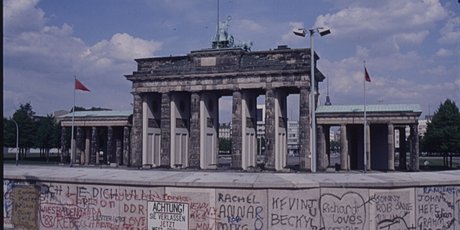The Berlin Wall has had starring roles in very different kinds of films, ranging from dramas and thrillers to comedies. The Wall was especially popular in international espionage films because it clearly represented the Iron Curtain between the two sides of the Cold War. Meanwhile, by the 1980s, West German comedies began to satirise life in a country divided by a wall. In East Germany, the so-called "Anti-Fascist Protection Wall" was a taboo subject, even in films.
A Small Selection
One, Two, Three
Billy Wilder's sharp-tongued comedy One, Two, Three makes fun of everything: the capitalist Americans, the communist Russians and the Germans still marching to the orders of whoever's in charge. The construction of the Wall during shooting in 1961 required the Brandenburg Gate to be recreated in a Munich studio. Since no one felt able to laugh about the separation of East and West immediately after the Wall, the film was a flop. It was only in the 1980s that the film was rediscovered in West Berlin art-house cinemas and enjoyed great success.
Escape from East Berlin (1962)
The first feature film about the Wall: Escape from East Berlin was filmed in 1962. With an international star cast (Don Murray, Christine Kaufmann, Ingrid van Bergen), director Robert Siodmak tells the story of an escape in a self-built tunnel. The film had its première in the Kongresshalle (now known as the Haus der Kulturen der Welt) near the Wall.
Torn Curtain (1966)
East Germany from an American perspective: in Alfred Hitchcock's thriller Torn Curtain, American scientist (Paul Newman) travels behind the Iron Curtain. The film was shot in West Berlin, among other locations, and attentive viewers may recognise Fehrbelliner Platz. At the end, there is a successful escape back to the West, not across the Wall, but via the Baltic sea to Sweden.
Funeral in Berlin (1966)
With Michael Caine as spy Harry Palmer, the gripping thriller Funeral in Berlin begins with an exciting escape scene with someone being smuggled by a crane over the Wall. Many scenes show West Berlin shortly after the construction of the Wall and the Wall can still be seen in its early phase of construction.
Meier (1986)
The comedy Meier addresses the division of the city and life in East and West. Meier, an East Berliner, inherits property in the West and obtains a West German passport, but remains in the GDR and smuggles wallpaper into East Germany, making him the hero of his workplace. Every night he crosses the border. In the most famous scene of the film, Dieter Hildebrandt plays a waiter in a seafood restaurant who responds to every item order "Hamwanich" ("Ain't got that").
Der Mann auf der Mauer (1982)
Like Meier, the satirical comedy drama Der Mann auf der Mauer ("The Man on the Wall") revolves around a "Wall Jumper," a commuter between East and West (and the title of the story by Peter Schneider that inspired the film). Kabe (played by Marius Müller-Westernhagen) doesn't feel at home in either East or West.
Octopussy (1983)
Even James Bond made it to East Germany: Top British spy James Bond crosses Checkpoint Charlie into East Germany to go to the Octopussy Circus performing in Karl-Marx-Stadt (now Chemnitz). The Cold War and the arms race are the background for the thriller Octopussy, which also plays in Cuba and in India.
Der Himmel über Berlin (1987)
Wim Wenders' Der Himmel über Berlin, known in English as Wings of Desire, is the Berlin film par excellence and it still enchants its viewers with its black and white poetic imagery.
The angels don't just go through walls but also through the Wall. There were plans for scenes at the Brandenburg Gate (still located in East Berlin at the time), but the script was rejected by the East German authorities. The film shows a Berlin Wall which angels can pass through effortlessly. Potsdamer Platz, located directly against the wall, is an urban desert in the film, but has since been completely rebuilt with skyscrapers.
Sonnenallee (1999)
Leander Haussmann's film Sonnenallee, released in English as Sun Alley, shows the comedic and tragic absurdities of growing up in the shadow of the Wall. The Wall divided Sonnenallee, with only its shorter southern section in the GDR.
Helden wie wir (1999)
On the tenth anniversary of the Berlin Wall's fall, the film Helden wie wir (English title: Heroes Like Us) had its première. Based on Thomas Brussig's picaresque novel, the film tells the bizarre story of East Berliner Klaus Uhltzscht, who, we are told, is responsible for the fall of the Wall.
Goodbye Lenin (2003)
Shortly before 9 November 1989, Christiane Kerner (Katrin Sass) falls into a coma and misses the fall of the Wall. After she wakes up, her family tries to conceal the changes that have since taken place. At the end, the son shows a film of the Wall's fall in which the West Germans, tired of capitalism, storm the East German border which the GDR government generously opens. The warm-hearted comedy Goodbye Lenin was a huge success with audiences and critics.
Coming Out (1989)
Not a film about the Wall per se, but still connected to the fall of the Wall. Coming Out was the first East German film about homosexuality. The première took place on 9 November 1989 at the Kino International.
While about 600 guests were watching the film, news broke that the Wall had been opened.

